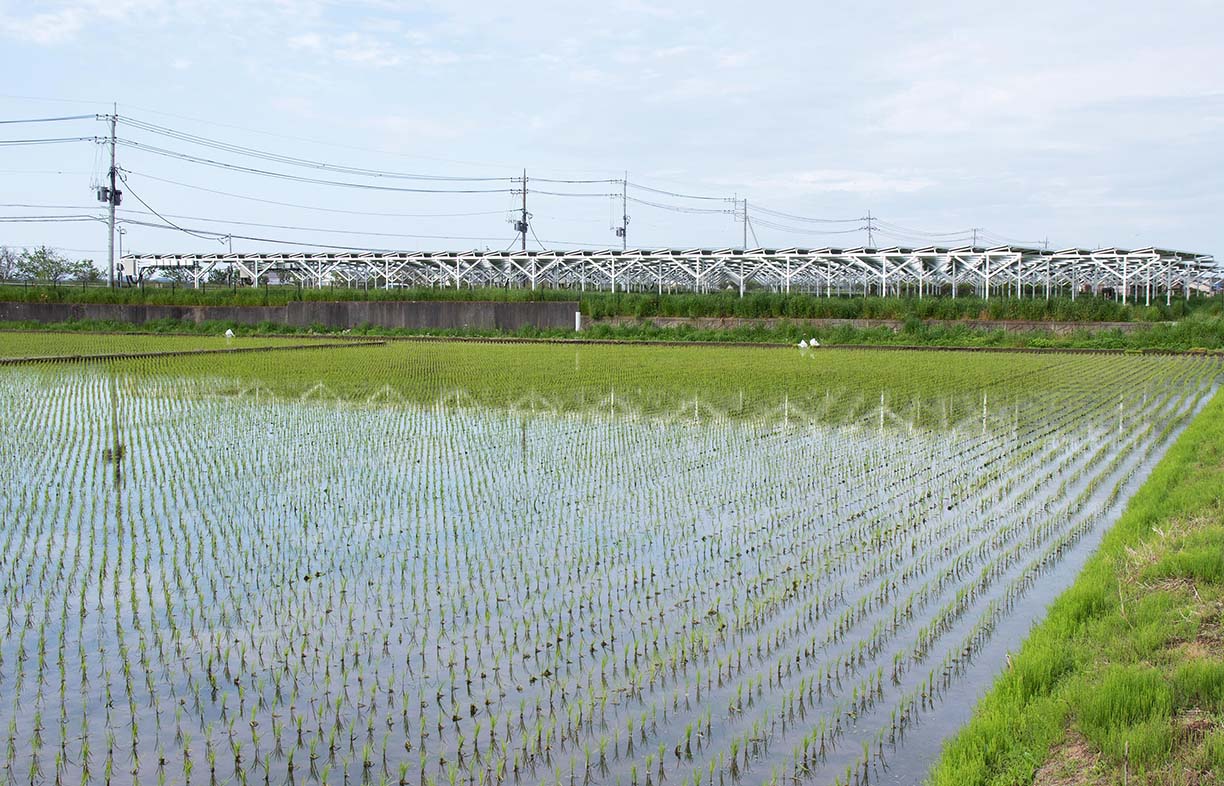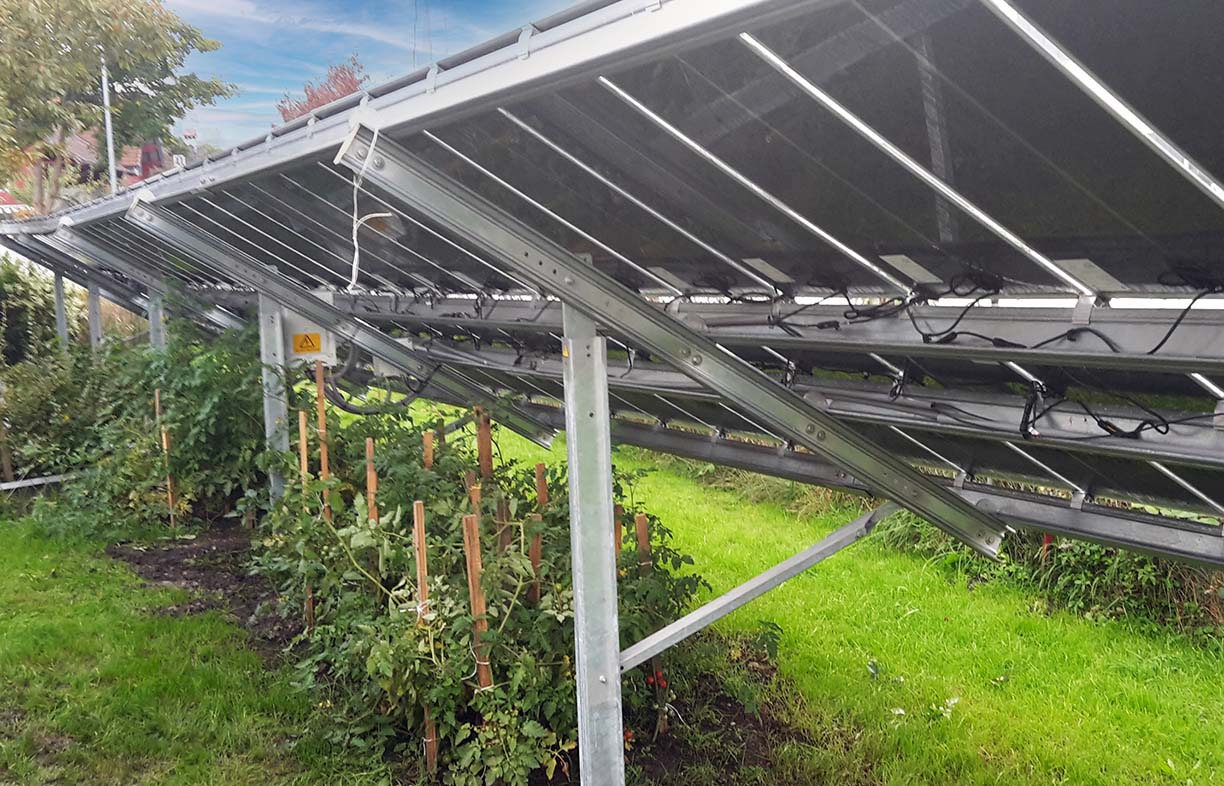
Agrophotovoltaics, agrivoltaics, or APV. Just like the name suggests, it's a way of combining photovoltaic solar panels with agriculture. In many parts of the world where fertile land is scarce, agriculture and solar developers have fought over available space. What each party might have been missing all along is that it could be more profitable for both of them if they worked together instead. And that may also just be the answer to the existential crisis being faced by so many farms across the world.
Is sharing high-value land between agriculture and renewable energy generation the future? And will it be enough to save the planet? Rémi Rauline and his fellow authors make the case for agrivoltaics.
As the world’s population continues to grow, so does demand for land capable of fulfilling our primary needs: food, shelter and energy. This continued growth in population also sees an ever-increasing level of stress placed on all earth’s ecological systems.
In Australia, the Australian Bureau of Statistics projects a population of about 30.9 m to 42.5 m by 2056 and between 33.7 m and 62.2 m by 2101. While the amount of land here on our island continent seems immense, our primary needs and our international role as a food producer can only be fulfilled in restricted areas—areas where rainfall, agricultural value and existing infrastructure, such as the electricity network, make food production possible.
According to ClimateWorks Australia’s report Land Use Futures, produced this year in collaboration with Deakin University and the CSIRO, some 53% of Australia’s area is already used for agriculture—including an intensive use zone concentrated around the southern and eastern coasts, which covers only 13% of our landmass but is responsible for almost all irrigated farming and a third of the agricultural sector’s output. Another 40% of our country is set aside for conservation or otherwise protected. Suddenly, Australia looks fairly small—and as both our population and that of the world grow, pressure on high value agricultural land will only increase.
Through international (the Paris Agreement, ratified in 2016) and state commitments (Victoria’s Climate Change Act 2017), Australia recognises the critical need to achieve zero net emissions by 2050. In 2019, 33% of Australian carbon emissions came from electricity generation, with only 21% of Australia’s total electricity generation coming from renewable sources—wind (7%), solar (7%) and hydro (5%). To meet our emissions targets, we need to increase the proportion of renewables sources five-fold.
The plan for this transition is mapped out in the Australian Energy Market Operator’s latest Integrated System Plan 2020. The AEMO plan recognises that wind and solar are both pragmatic, low-carbon and low-cost sources of energy for the Australian market. However, both wind and solar need extensive amounts of land. This land must meet key criteria to farm embedded energy from solar rays and wind flows. It must:
• be relatively flat, with great wind or solar potential;
• be accessible by road;
• fulfil planning zoning conditions; and
• be close to the existing grid.
So if our need for food, shelter and energy is increasing, and the amount of land to satisfy them is physically limited, the question becomes: how do we innovate to meet the challenge?
Ensuring food security requires dramatic changes in both consumer behaviour and farming practice. The intensive farming model has been degrading soil, producing low nutritive food and limiting resilience to climate change by reducing the range of crops to a few highly productive species.
If we want to feed our growing population, the agriculture of tomorrow is yet to be invented and the renewable industry can be part of the solution by using the same land
for both energy generation and agriculture, especially in areas of high agricultural value. This concept, known as “agrivoltaics” (and also as “agrophotovoltaics”, “solar sharing” and “agrovoltaics”) has been researched extensively over the last 30 years, especially in countries with small landmasses and/or high land prices. In those areas, we have now reached a point where implementing agrivoltaic solutions has become feasible.
In agrivoltaic projects, land use can be combined in a virtuous circle, where energy generation infrastructure provides shelter for crops and better water efficiency, while using land for crops and grazing results in a shade- free environment for solar panels.
Competition for land use in Australia
So why does this matter in Australia? The answer is that, while Australian renewable energy production has undergone a remarkable expansion over the last decade, the continuation of this expansion is now being impacted by a power grid that limits renewable contributions to geographically restricted areas that often also support high value agricultural production.
In 2019 alone, 11.1 GW of renewables were committed or under construction. Considering an average of approximately two hectares of land per MW of power, that’s over 20,000 hectares of land, equivalent to four Sydney Harbours or 12,900 MCGs.
In countries overseas, especially in Southern Europe, farmers have protested against the proliferation of solar plants in the landscape. Similar objections are now being seen more frequently in Australia, where renewable energy generation and high value agricultural production priorities are starting to coincide—to date, the great majority of solar farms built have been on lower quality farmland, but this will not always be the case.
In September 2018, for example, the Shire Council of Corangamite (in south- west Victoria) received 80 objections to a proposed $150 million solar farm in the region of Bookar. The project would have generated 200 MW via 700,000 panels, which were to be installed on 554 hectares of farmland. Speaking to a council meeting about the solar development, Councillor Simon Illingworth summarised the nature of the objections: “You can’t cut down a tree without having to replace the tree, but you can wipe out 1500 hectares of farmland while in the middle of the worst drought in Australia’s living history?”
The solar project was finally refused planning approval by the Victorian Civil and Administrative Tribunal, on the basis that there was insufficient information contained in the planning documentation, along with significant issues around drainage and fire control, loss of agricultural land and community opposition.
In early 2018, the Victorian Minister for Planning was asked by the Greater Shepparton City Council to decide on the outcome of four solar farm permit applications in Victoria’s Goulburn Valley. The first of the proposals, the 68 MW Congupna solar farm, was approved in October later that year, but the remaining three—the Lemnos, Tallygaroopna and Tatura East solar farms— faced significant delays due to opposition from local farmers, and were not approved until late in 2019. The three delayed proposals will consist of more than 650,000 solar panels and generate 175 MW of renewable energy into the power grid, but will also be built on former irrigation properties. These properties had previously benefited from hundreds of thousands of dollars in grants to upgrade irrigation equipment—equipment that will never be used again.
Similar conflicts between farmers and renewable developers have arisen near Mildura, Victoria, with Powervault
being refused approval for two 7.5 MW developments on agricultural land, and at Culcairn in the NSW Riverina, where Neoen failed to get approval for a 400 MW solar farm.
Some states have tried to help developers, communities and councils navigate land conflict dilemmas. In Victoria, for instance, new planning guidelines (the Solar Energy Facility, Design and Development Guidelines) were released in July 2019. These guidelines are directed at encouraging investment and providing certainty for councils and developers around acceptable outcomes for land, communities and the environment. Under the new rules, the state’s Minister for Planning became the responsible authority for large scale renewable energy facilities. (This was previously the role of local councils.) The development of solar facilities became more consistent and reliable; however, conflicts continue to emerge in Victoria and across Australia.
While it is important to find pragmatic solutions for locations around high value agricultural land, we should also keep in mind that—in theory, at least—only a few hundred square kilometres of land would be sufficient to meet all of Australia’s electricity needs. In addition, many of the solar farms built to date have been on very low or lower quality farmland. Nevertheless, it is clear that a better solution is needed.
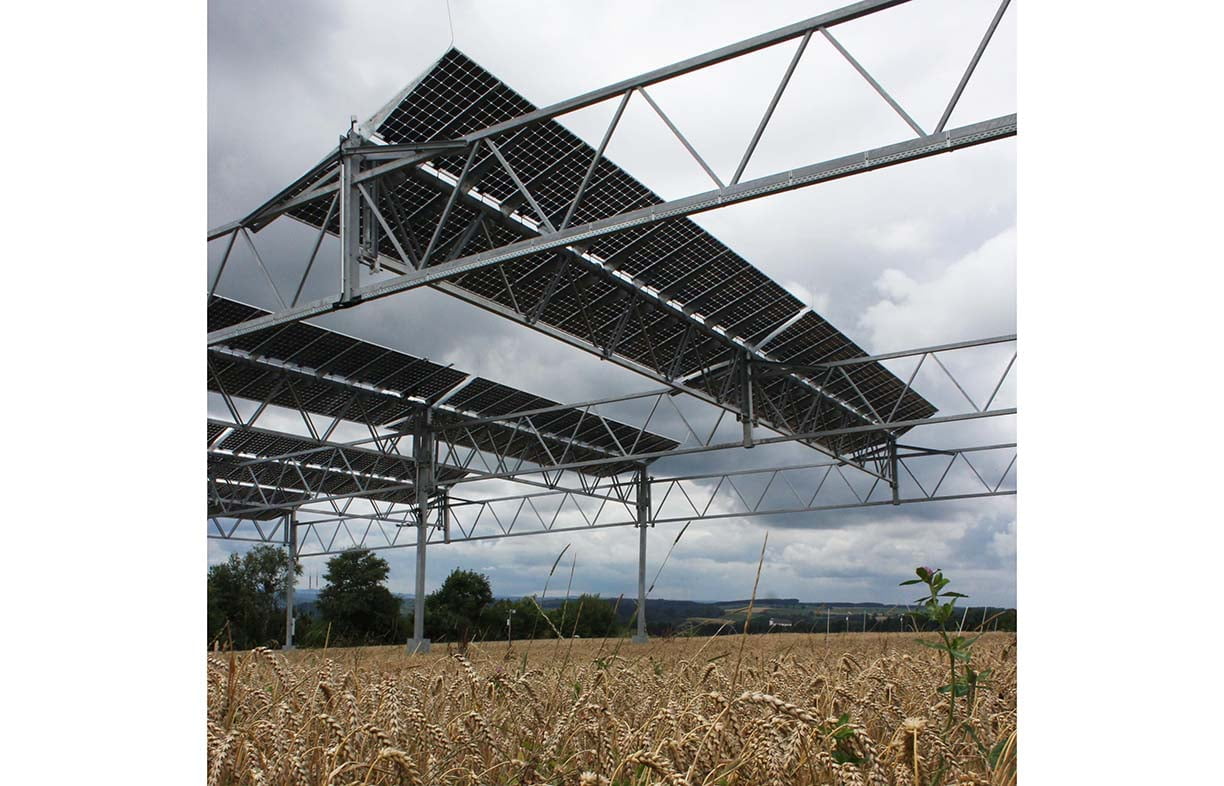
How does agrivoltaic work?
The idea of using land for both solar power generation and crop cultivation is about 40 years old (at least insofar as humans are concerned—nature has enjoyed the concept since the emergence of photosynthesis).
Initially, the objective of agrivoltaic technology was first to harvest the photons in excess of the light saturation point of the crops on the land they shared. (The light saturation point is essentially the maximum amount of photons absorbable by a plant species.) It has now moved to synergy between the two uses; either way, the idea is to produce energy while also providing additional income for farmers.
So how does it work? The concept is fairly simple in principle. Most commonly, solar panels are attached to taller arrays to allow farm production beneath (machinery access, animal movement, crop growing). Panels were originally spaced to allow for optimum light access and/or specific wavelengths to reach the plantings and the PV cells. Today, the methods for achieving this are more sophisticated; panels can be made translucent and/or mechanically operable, allowing finer control of the amount and/or wavelength(s) of light that are absorbed by the panel or allowed to reach the crops. The panels can also mitigate risks associated with extreme weather conditions, shielding crops from storms, drought and/or hail.
The process is still evolving: research is ongoing, and ways are being found to adapt solar sharing to the production processes of many different fruit and vegetables.
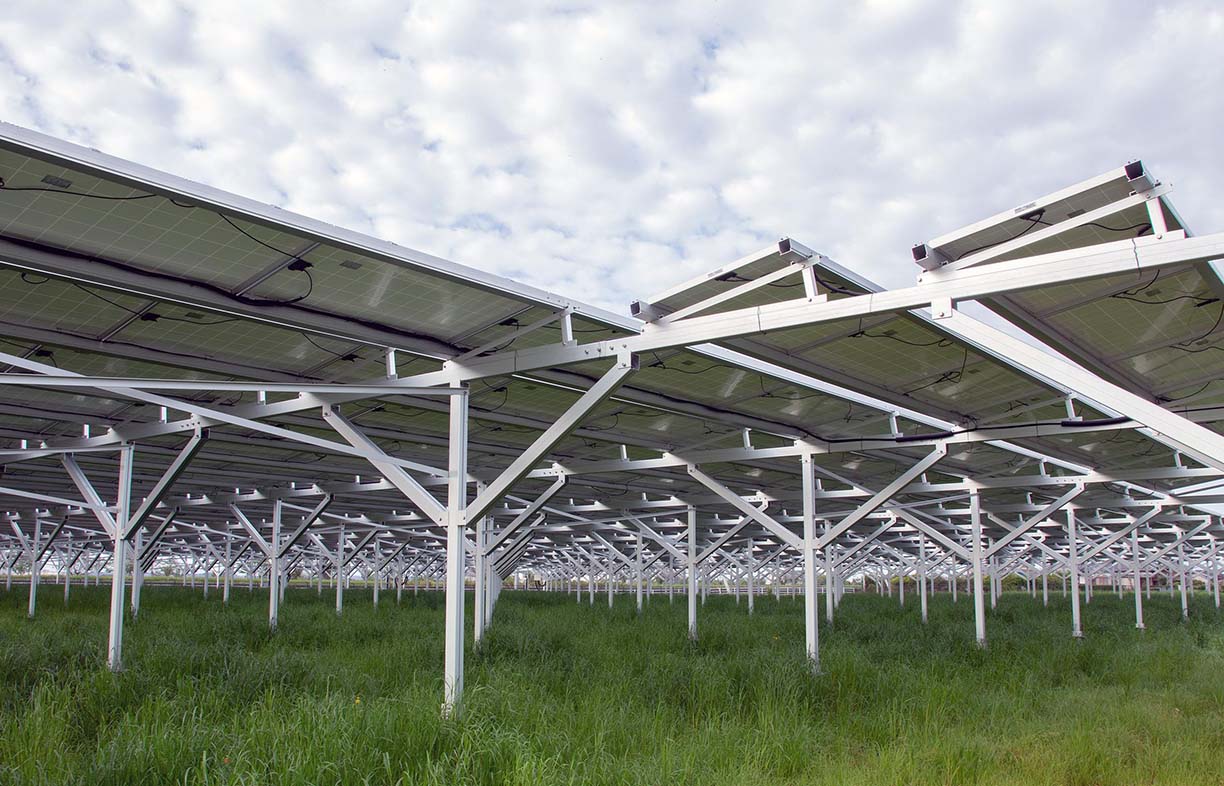
Agrivoltaics around the world
While agrivoltaic projects are still rare in Australia, there is plenty of evidence from around the world for their effectiveness—in particular, from Europe and Japan, which have embraced the idea enthusiastically.
– Europe:
In France, research conducted on a vineyard showed that solar panels reduced water irrigation needs between 12% and 34% (through shading) and also increased the quality of the fruit: grapes grown in this manner will generate an additional 13% of anthocyanins (the phenolic compounds that give red wine its distinctive colour) and 9% to 12 % of additional acidity. Panels were operable and could provide adequate shelter in evolving climate conditions.
In the UK, a research team led by Professor Paolo Bombelli from the University of Cambridge has developed tinted semi- transparent solar panels that operate on specific wavelengths of light, allowing plants and solar cells to harness different parts of the visible spectrum. By customising the absorption spectra of the photovoltaic panels, the team was able to create specialised solar panels that absorb high energy wavelengths in the blue (between around 400 nm and 500 nm) and green (around 500 nm to 600 nm) region of the visible spectrum to limit light stress in plants. “Customising the absorption spectra of photovoltaic panels allows them
to harness light in the region of the solar spectrum where plants are less effective,” wrote the authors in their study. The team analysed how growth under the semi- transparent panels affected plant metabolism and phenotype. The plants demonstrated a more efficient photosynthetic use of light (up to 68% for spinach) and their metabolic energy was found to be redirected toward growing tissue above ground.
Still in the UK, renewable energy developer Ecotricity became one of the first “bee guardian” businesses in the country for its plans to create a “bee haven” at its solar farm in Lincolnshire. They planted a 20,000-panel solar farm with native wildflower seeds to encourage bees and insects to the site. The concept has since been replicated in the USA by Fresh Energy.
In the Netherlands, German company BayWa r.e. and its Dutch subsidiary GroenLeven are building five pilot agrivoltaic power projects. The test crops are blueberries, red currants, raspberries, strawberries and blackberries. The panels provide cooler conditions for the plants and more stable humidity. BayWa r.e. designed a semi- transparent module allowing sufficient sunlight for the plant while protecting the crop from direct sunlight and other climate conditions (hail, heavy rain, etc). The project is being extended to 2.7 MWp.
– The USA: mutual benefit
In the USA, the Barron-Gafford research group investigated agrivoltaics for increasing the resilience of renewable energy and food production in drylands where crops are grown in the partial shade of the solar infrastructure. They demonstrated that the reduction of incoming active radiation under the PV panels yielded cooler daytime air temperatures and also higher moisture in the air, resulting in fruit production three times greater than on a control plot under an open sky. The influence of agrivoltaic systems on soil moisture showed that soil moisture remained 15% higher than in control settings and PV panels were around 9°C cooler in daylight hours; this could lead to a 1% increase of energy generation annually. This shows how agrivoltaics can be a win-win system, in which both crops and solar panels have mutually beneficial effects.
– The leading country: Japan
Japan is at the forefront of solar sharing in Asia and globally: in 2017 solar sharing projects in Japan generated about 230 MW over 330 hectares of land.
In the early 2010s, experimentation started with the development of tall, light- weight solar racks, which would allow for machinery to operate beneath, and also provide intervals for sunlight to hit the ground for photosynthesis. The data collected has been used as a precursor for shading rates depending on crops.
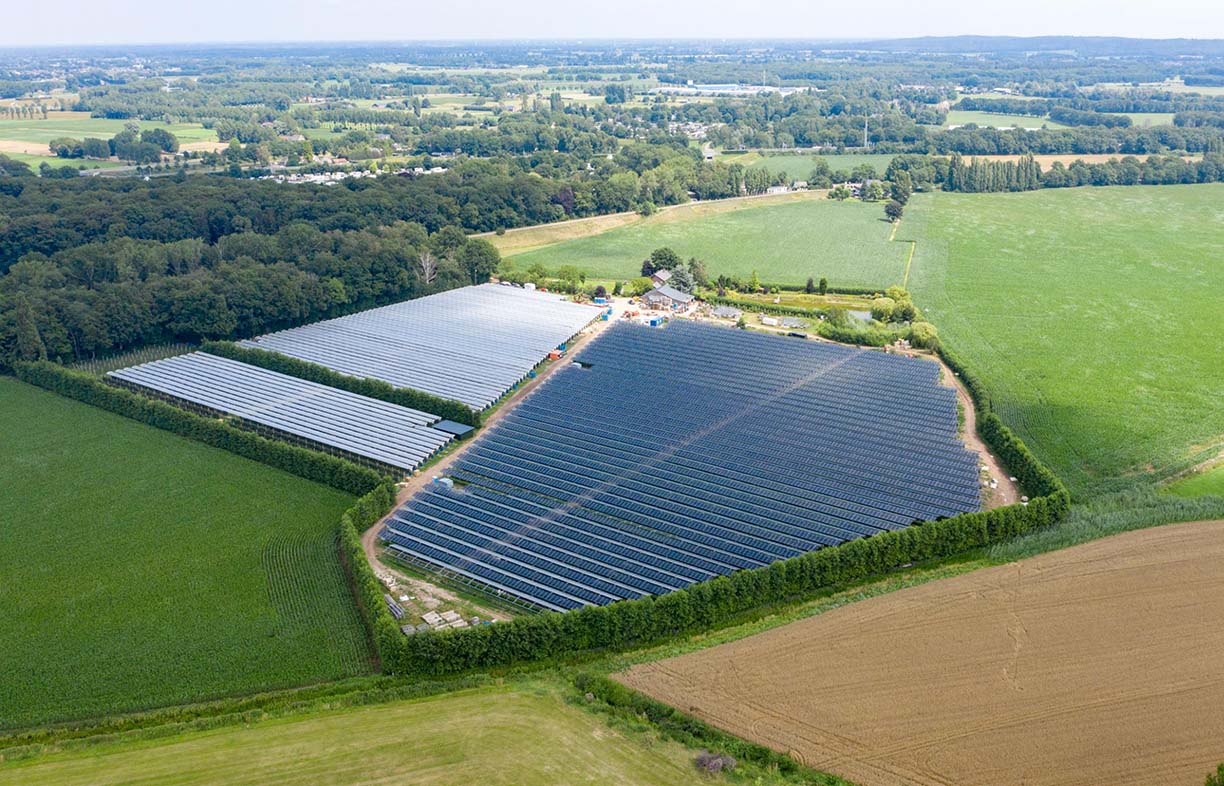
Why are plants green, anyway?
The solar panels designed by the team from the University of Cambridge (see “Europe”, on facing page) are designed to provide mutual benefit for plants and people. They do this by working to give plants the light that they want, while finding a use for the light that plants don’t want. To this effect, they are transparent to the wavelengths of light that plants can absorb, while absorbing the wavelengths that plants reflect.
Apart from being an extremely clever design, these panels also allude to a question many of us have pondered at one point: why are plants green? The answer also explains which wavelengths the panels transmit, and which they don’t: plants absorb pretty much every photon of red and blue light they can find, but this isn’t the case with green light, which they reflect. That green light reaches our eyes, making plants appear green.
But why? Why do plants reflect green light instead of absorbing it? Why not absorb all wavelengths? The more the merrier, right?
The answer to this question is less certain, but one theory comes from the ancient history of our planet—and specifically from the first organisms that evolved to tap the sun’s energy for food. These organisms were bacteria called cyanobacteria—and as the name suggests, they’re blue. (Here in Australia, we’re all too familiar with them, in the form of blue-green algae.) These bacteria do the opposite of what plants do; they absorb green light, while reflecting red and blue wavelengths.
The ability to use sunlight to create free food made cyanobacteria extremely successful, so much so that by about 2.4 billion years ago, they dominated the earth’s surface. This meant that the first plants had to feed on the scraps they left: red and blue light. Plants therefore evolved to absorb and photosynthesise those wavelengths, not bothering with the green light that was rarely available to them anyway. So it is that, billions of years later, they do the same thing—and that the creatures who’ve replaced cyanobacteria as the earth’s dominant life form (us!) see them as… green!
Sources: SciShow, Quanta Magazine
Agrivoltaics in Australia
We’ve already discussed the case for agrivoltaics in Australia from the standpoint of conflict resolution and efficiency of land use. However, it’s also important to realise that this country stands to benefit hugely from both renewables in general and agrivoltaics in particular.
Australia is widely recognised as offering one of the highest potentials for renewable energy production in the world—the increasingly common phrase is that Australia has the capacity to become the “Middle East of renewables”. We could well become a world leader in hydrogen production, powered by renewables, a status that could potentially generate a multi-billion dollar boost to our economy.
If strategies, policy and political vision are aligned pragmatically, the objectives of the Paris Agreement—combined with the need for a price of less than $2 per kg of hydrogen at the farm gate to make Australian hydrogen competitive—require a dramatic expansion of solar facilities in Australia. The availability of ideal sites for solar (i.e. sites combining proximity to existing grid and population, flat land and low agricultural value) is running out, and conflicts between crop and energy farmers—real and perceived—will only become more costly and counter-productive for all parties.
This only makes it more frustrating that the concept of agrivoltaics remains barely researched in Australia. To date, there are a limited number of formal research projects in this country. These include a trial of
sheep grazing on a solar farm in the central western region of New South Wales, which is investigating potential benefits of grazing 120 wethers around a group of solar arrays. The early results from this project in terms
of animal health and wool production are very encouraging. There are also a number of solar farms across Australia that are successfully grazing sheep on the land as land management practice, but there is no formal data on the extent and outcomes of these activities.
There are no legislative barriers to agrivoltaics in Australia today. In fact, the Victorian DELWP Guidelines—developed in 2019—have recognised the concept and potential of agrivoltaics: “The cumulative impacts of solar energy facilities on an area can be reduced by:
- having enough distance between solar energy facilities within an area to minimise or avoid environmental impacts and natural hazard risk exposure.”
If state planning authorities are now discouraging projects on very high value agricultural land (such as irrigated land), the main barrier to agrivoltaics in Australia is understood anecdotally to be a lack of knowledge of the benefits of shared land use.
Increased awareness of the opportunities of agrivoltaics, along with locally proven solutions, will build the confidence of developers to partner with farms to deliver agrivoltaic solutions.
This problem can be solved by sharing information through avenues such as this article, and by demonstration projects where approaches from international experience can be adopted locally to provide reliable (and bankable) data for future projects.
